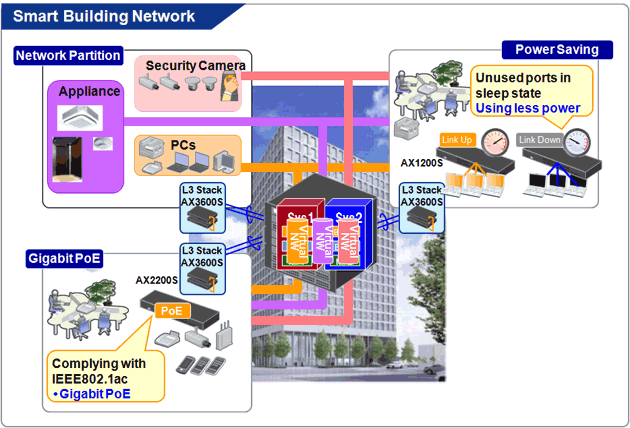Building automation (BA) using cutting edge information technology is an important factor in urban planning and construction of social infrastructures.
It could be said that sophisticated modern buildings, often called “ smart buildings”, are huge machines in which various systems, such as for security (e.g., security cameras, identification check, etc,), lighting, ventilation, fire prevention and so on, are working together around the clock, linking with each other. In addition, wide-spread use of digital signage, video conference, etc., is spurring construction of building complexes.
Usually, in a building complex (a building comprised of several buildings), each building uses its own facilities, therefore overuse of resources is reaching a critical level we cannot ignore anymore. As a way to reduce costs and increase added values of buildings, network integration is now drawing attention.
Key points for BA using IT
- Ensuring security among systems at low costs (biggest challenge facing integrated networks)
- High-availability and high-reliability network that does not stop building automation
- Reducing unnecessary power consumption as much as possible (BA consumes much power)
Virtual network ensuring security of each system
Integrating multiple systems (e.g., security camera, identification check, etc.) into a single network brings various benefits such as reduced costs, less use of energy, enhanced convenience, etc. On the other hand, as such integration makes it difficult to ensure security of each system, we must find a way to eliminate security threats. However, additional investment for security enhancement strains the budget of a building owner.
In network integration, Network Partition (virtualization solution) ensures the independency of each system by logically dividing a network, providing the same level of security as that of a physically divided network.
Further, it uses the existing techniques of LAN switches and does not require special equipment. With its easy operation management, you can minimize both initial costs and running costs.
Fault tolerant network that never stops
In buildings, in addition to the facilities we use on a daily basis (e.g., elevators, ventilation systems, etc.), security systems (e.g., security cameras, identification devices, etc.) are installed, all connecting with each other on an integrated network. Under such circumstances, network failure must be fixed immediately.
ALAXALA’s fault tolerant switches (FT Switches) support multicast non-stop forwarding, allowing networks to recover from faults immediately without stopping services. Further, the switches have two-in-one architecture (containing the functions of two switch units) and enable hardware-based fast switchover (50ms), being suitable as a core switch of building networks.
Reducing unnecessary power consumption
Advanced building automation contributes to the promotion of energy saving (e.g., detecting vacant rooms and turning lights off automatically). Under this concept, ALAXALA proposes dynamic power saving, which enables automatic reduction of power consumption when facilities are not in use (during nights/holidays).
If used as a core switch, the AX series can enter the performance degradation mode during low traffic periods, thus reducing use of power. If used as a floor switch (in a meeting room, for example), it can enter the sleep mode when the room is unoccupied. Dynamic power saving will be a new power saving option for your building automation.
Ensuring building security using security cameras
To ensure security, image data captured by security cameras must be retained even during traffic convergence. The AX series enables fine-tuning bandwidth adjustment for each system. By reserving bandwidth for security cameras, image transmission without interruption / delay becomes possible.
Gigabit PoE switch suitable for service using security cameras / wireless APs
To connect security cameras and wireless APs, PoE switches are required. The AX2230S, supporting Gigabit Ethernet, can show its best performance even with the next generation standard IEEE802.1ac.
Network configuration image

Switches
Layer 3 chassis-type switches
- AX6700S/
AX6600S/
AX6300S Series -
10 Gigabit Ethernet switches offering carrier-grade high reliability that enables non-stop networking, suitable for mission critical enterprises
(Network partition, FT switch, IP Multicast that enables accommodation of a maximum of 3000 security cameras)
Layer 3 box-type switches
- AX3800S Series
-
Layer 3 box-type switches for accommodating multiple 10 Gigabit Ethernets, suitable as a core switch in medium/small-scale enterprise LANs and data centers
(Network partition, Stack)
- AX3600S Series
-
Gigabit Ethernet layer 3 switches offering high reliability and rich functionalities equivalent to those of carrier-grade routers, suitable as a core or distribution switch in enterprise networks
(Network partition, Stack)
Layer 2 box-type switches
- AX2500S Series
-
Layer 2 Gigabit Ethernet switches offering high reliability and feature-rich functionality, suitable as a distribution or floor switch in enterprise layer 2 networks
(Stack, Dynamic power saving)
- AX2200S Series
-
High-performance, cost-effective layer 2 Gigabit Ethernet switches, suitable as a floor switch in enterprise mobile networks
(PoE, Dynamic power saving)
- AX1200S Series
-
Fast Ethernet switches offering robust security for network edges, suitable as a floor switch
(PoE, Dynamic power saving)



